
views
Minimizing the Effects of the Coffee
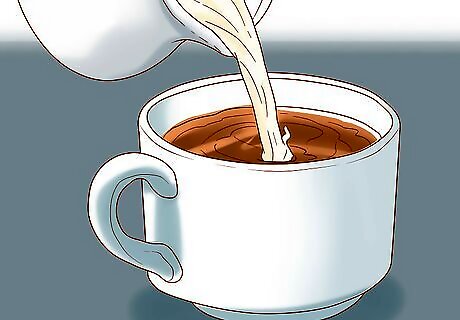
Add a splash of milk to your coffee. Half and half or milk can make your coffee tastier, but it can also reduce the stain-causing effects a bit, too. It doesn't take much to benefit from this technique. Just tip a small splash into your coffee. Also, the casein in milk helps prevent staining. In part, this makes coffee less acidic. Acid can make you more vulnerable to stains. Non-dairy creamers and plant-milk may help make it less acidic, but they don't contain the casein milk does.
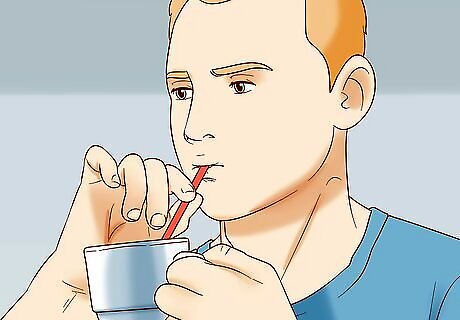
Drink your coffee through a straw. You may already do this with iced coffee, but you should try it with your hot coffee, too. A straw keeps the coffee from getting on your teeth as much, reducing the staining effect. Plus, it keeps it away from your front teeth, where you'll notice the discoloration the most. If you're worried about throwing away all those disposable straws, opt for reusable versions in metal or sturdier plastic.
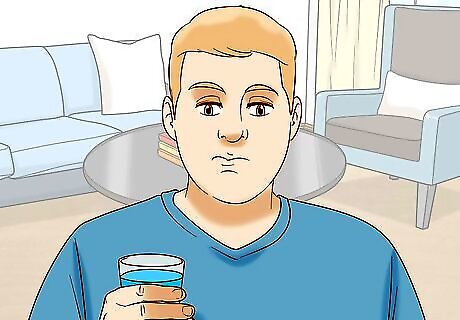
Rinse your mouth out with water after you drink coffee. Drink some water and swish it around in your mouth for at least 30 seconds. Once you're done swishing, you can swallow the water or spit it out depending on your preferences. The water will remove the remnants of the coffee so it can't stick around and stain your teeth more.
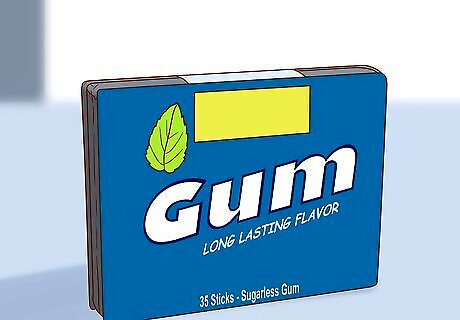
Pop a piece of sugarless gum after drinking coffee to reduce the acid. When you're done with your coffee, reach for the gum. Chew it for at least 20 minutes or so to decrease the amount of acid you have floating around. Neutralizing the acid will make you less susceptible to coffee's staining effects.
Caring for Your Teeth
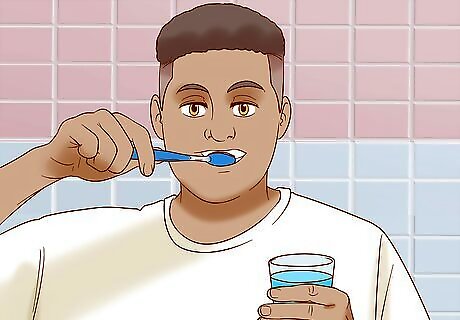
Brush your teeth at least twice a day. Brushing won't prevent staining completely, but it will help keep it to a minimum. Make sure you're following your dentist's recommendations for brushing, brushing your teeth at least twice a day. When brushing, set the brush at a 45-degree angle to your gums and try to brush for at least 2 minutes each time. Make sure you're brushing all the surfaces of your teeth. Plus, the plaque that builds up on your teeth will show stains more readily than your teeth enamel. Try switching to an electric toothbrush, as it tends to remove more plaque than just regular brushing. Avoid brushing too aggressively, as that can wear down your enamel. Wait at least 30 minutes to brush after drinking coffee. If you brush too soon, you may be scrubbing the acid into your teeth, making its wearing effect worse.
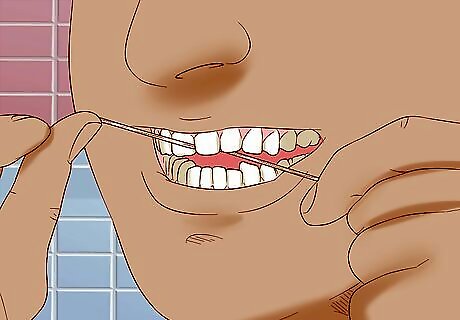
Floss once a day to remove plaque. Pull out a length of dental floss that's about 18 inches (46 cm) long. Wrap a small part of it around your middle finger on 1 hand and the rest around your middle finger on the other hand; wrap more around one finger than the other. Leave enough in between your fingers to floss with, about 1 to 2 inches (2.5 to 5.1 cm). Use your index fingers and thumbs to guide the floss into the spaces between your teeth. Rub it back and forth, making sure you don't push it too hard into your gums. Make a "C" shape around the teeth in each direction as you move up and down. As the floss gets dirty, pull out some that's clean from the middle finger that's holding the length of thread. Wrap the dirty part around your other finger. Flossing helps remove the plaque that will show stains. You can get whitening floss, but it likely won't provide much more benefit than just using regular floss.
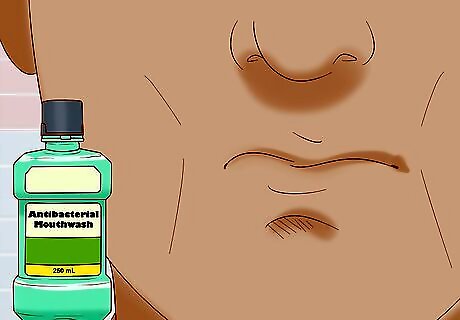
Rinse with an antibacterial mouthwash before or after brushing. This type of mouthwash helps you avoid the buildup of plaque. Because plaque is more likely to show stains, it's a good idea to reduce buildup as much as you can. Try swishing with it twice a day, such as after breakfast and lunch.
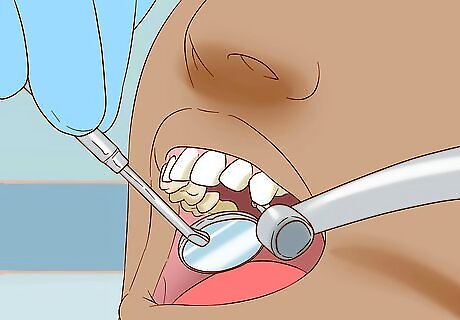
See your dentist for a cleaning every 6 months. Dental cleanings won't remove stains completely on their own. However, they may help keep stains from building up over time. You should see your dentist twice a year for cleanings, which will also help prevent the buildup of plaque on your teeth.
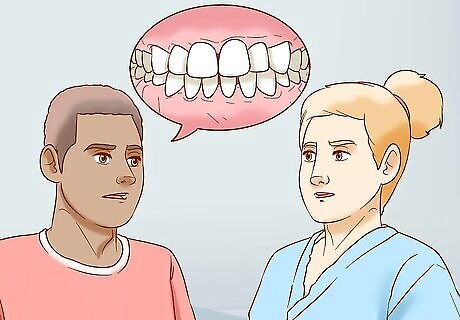
Talk to your dentist about professional whitening services. The dentist will evaluate your stains and make a recommendation about the best options for your situation. They may recommend products like trays that cover your teeth with whitening solutions for specific periods of time or bleaching solutions that are activated with light. You can also try a procedure like dental bonding, which basically covers your tooth in a lighter colored material that's bonded to the tooth with light. Veneers are another option, which is essentially a shell that goes in front of your teeth to make them look whiter.
Whitening Your Teeth at Home
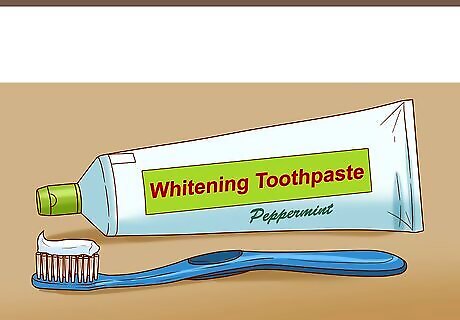
Try a whitening toothpaste to whiten over time. Whitening toothpastes aren't as effective as other whitening products, but they can help. However, replacing your regular toothpaste with a whitening one is an easy swap. Look for ones that use peroxides for whitening rather than abrasives. Abrasive toothpastes can wear down your enamel over time, making your problems worse. You can combine these toothpastes with whitening mouthwashes for a stronger effect.
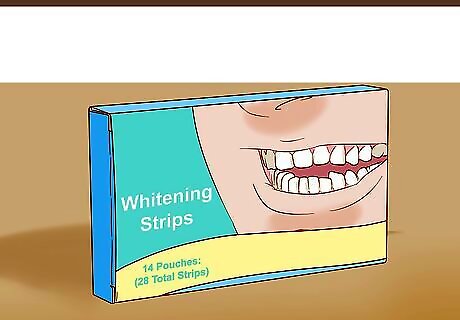
Apply whitening strips for a more effective whitener. With these products, you peel off the strips and place them over your teeth. Depending on the product, you may leave them on for up to an hour before peeling them off. Always read the instructions on the products before applying the strips. Also, read the directions to learn how often you can use them; often, you should only apply them for 5 minutes a day. Don't brush your teeth before using the strips, as they'll stick to your teeth better. Similar options include whitening mouth trays and gels that you apply to your teeth.
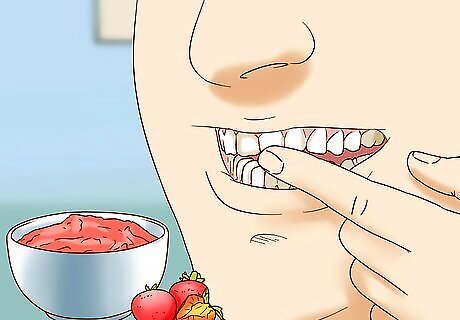
Spread mashed strawberries on your teeth for a natural solution. Some people have luck using strawberries to whiten their teeth, which have a natural enzyme that may help. Mash a bit up to rub into your teeth and leave it there for at least 5 minutes before you rinse. Brush your teeth after using this treatment. Don't use this treatment more than once a day.

Add crunchy fruits and veggies to your diet. Eat produce like apples, carrots, bell peppers, and celery. The hard produce will help remove plaque. Plus, they increase your saliva production, which washes away plaque and bacteria. Keep plaque in your mouth to a minimum to help decrease the appearance of stains.
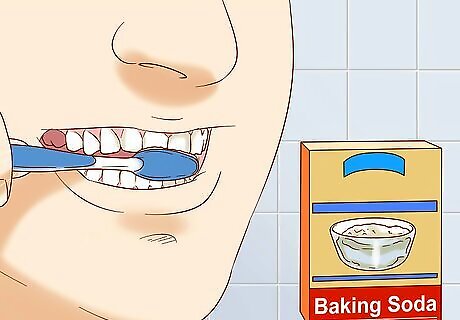
Use baking soda when brushing for mild abrasion. Either pick a toothpaste with baking soda or add a little to your toothbrush before your toothpaste. Brush as you normally would and then rinse it out. Picking a toothpaste with baking soda will taste better. Baking soda is very salty. Baking soda is mildly abrasive. It helps to remove stains, but it's not so abrasive that it wears down your enamel. Always talk to your dentist, but typically, you can use this technique every time you brush.


















Comments
0 comment